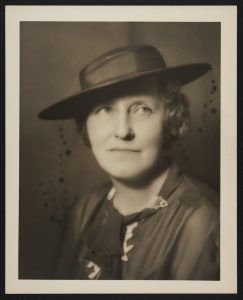
The life of Harriett Allyn was marked by two love interests: Anthropology and Mount Holyoke College. In a letter addressing her call to deanship, Allyn reflected upon the offer and was torn, noting that her anthropological work would have to come second to her administrative position. Nevertheless, she concluded her letter with “but you see I love Mount Holyoke” and accepted her new role. Still, her love for anthropology remained close and with these two interests at heart, Allyn’s career marked an era of success and progress at the college. In the two decades of her deanship, she proved to be a ground-breaking figure in Mount Holyoke history and especially the development of its Anthropology Department.
The Formative Years
Harriett May Allyn, born May 4th, 1883, showed immense promise and ability from an early age. In 1901, Allyn graduated from high school at Williams Memorial Institute in her home town, New London, Connecticut and joined the class of 1905 at Mount Holyoke College. As an undergraduate, Allyn was a distinguished student, not only academically, but also in her extra-curricular activities. A member of the debate society and avid participant in dramatic performances, Allyn’s skills were apparent early on. It is difficult to find an account that does not praise her gift for public speaking and her effortless, witty, and caring disposition. Her academic achievements were equally impressive; in her junior year she became president of her class and was one of ten students elected to the first chapter of Phi Beta Kappa at Mount Holyoke.
Allyn’s ambition and hard work did not diminish after graduating from Mount Holyoke in 1905 with a degree in Biology. In fact, her formative years were only the beginning of her drive for discovery and success. After she worked for several years as secretary to Mount Holyoke’s Young Women’s Christian Association (YWCA) in South Hadley and as an Instructor of Biology at Lake Erie College, Allyn earned her master’s degree in Zoology and Botany from University of Chicago in 1910, and her Ph.D. two years later in 1912.
Anthropology in Action
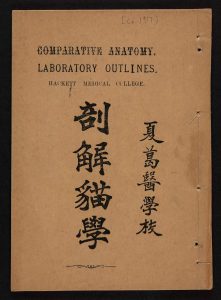
With years of study and advanced degrees under her belt, Allyn set out for Canton, China in the fall of 1913 to pursue a position as Instructor of Zoology at Hackett Medical College. However, her administrative abilities were soon recognized and she was appointed Dean of the college only two years later. While in China, Allyn became acquainted with Martha Hackett, daughter of the college’s founder and its president from 1915 until 1933. It is possible that this relationship marks the origin of Allyn’s interest in anthropology, as Martha herself had noted interest in the field. Their relationship also continued well beyond Allyn’s time in China as Hackett later joined Allyn on her excavation to Palestine and aided in the cataloging of Mount Holyoke’s collections in 1930. 1
After leaving Hackett Medical College in 1926, Allyn pursued her newfound interest in anthropology by joining Professor George Grant MacCurdy from Yale University and the American School of Prehistoric Research on a field tour to Europe. Over the course of four months they studied museum collections and excavated in countries across Europe, including Belgium, Holland, Germany, England, Czechoslovakia, Switzerland, and France. 2
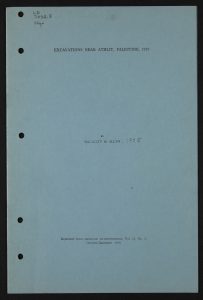
In 1928, Allyn began her work as a research fellow in the Department of Anthropology at Yale University, again under George Grant MacCurdy. During this time, she made many new contacts, including Dorothy Garrod, who was the first woman ever made full professor at Cambridge University in England. 3 It was Garrod who later invited Allyn to join an excavation in Palestine during the summer of 1929. Always ready for adventure, Allyn eagerly jumped on board and set out for the Mount Carmel Caves in Athlit, Palestine. She remained in Athlit from April through June as a member of an all-female group of anthropologists. Despite harsh weather conditions, limited resources, and a case of relapsing tick fever, Allyn was noted among the group for her enthusiasm and their findings proved abundant and of great intellectual value. So much so, in fact, that the dig continued intermittently for seven years, though Allyn herself did not participate beyond the initial three months. 4
Allyn at Mount Holyoke
Of all her positions and achievements, the longest standing and most notable was her period as Academic Dean at Mount Holyoke from 1929 to 1948. Over these two decades, Allyn paved the way for Mount Holyoke’s success on many fronts. Much of her work as Academic Dean was focused on answering student needs and establishing more effective communication between faculty and students. In the early 1930’s, Allyn initiated a series of major changes to the curriculum. These changes were made in the hopes of providing greater freedom in electing courses and to make majors “less narrow.” Allyn also founded interdepartmental majors for students whose academic interests “cut across departmental lines and who [had] an unusual academic focus.”5 In her effort to generate a more supportive relationship between faculty and students, Allyn also attended to the college’s advising system. Allyn believed that Mount Holyoke College was responsible for not only academic support, but also the overall well-being and growth of its students. Therefore, she made it her mission to enhance advising and counselling to help steer students in the right direction. Her attention to student support also extended to the college’s international students, who were offered the assistance of a committee for their guidance and a special adviser to help with matters, such as transfer credits and immigration restrictions. Together, these efforts to enhance the academics and student support at the college demonstrate Allyn’s progressive approach to administrative work and the lasting influence of her deanship.
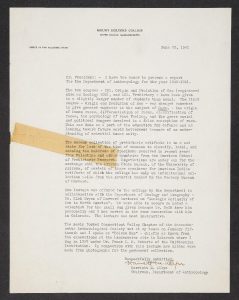
Even with all these accomplishments to her name, Allyn is most remembered, and rightly so, for her contribution to the development of the newly founded Anthropology Department. 6 It is safe to say that without her dedication to developing the field’s presence at Mount Holyoke, we would not have the excellent department today. Unable to give up her passion for anthropology, Allyn taught two courses, Prehistory and Origins & Evolution of Man, on top of her duties as academic dean. Until about 1941, these were the only two courses offered in the department and were largely based on physical anthropology at the time.
However, Allyn’s contribution to the department did not end here. Throughout her deanship, Allyn wrote several letters in the hope of furthering the expansion and academic development of the Anthropology Department and its course offerings. In 1941, she wrote one such letter to President Ham emphasizing the importance of educating Mount Holyoke students on matters of race, evolution, and eugenics. She felt that in the midst of events like World War II, changes of this sort were necessary as a way of “looking toward future world betterment [through] an understanding of essential human unity.”7 Her desire to expand anthropology courses to incorporate these ideas reflects her foresight and dedication to creating a department that welcomes progress, for she firmly believed that “no curriculum can remain static and be satisfactory.” 8 These changes were received positively by the campus community and the department saw a steady rise in student interest, which still continues to this day.

As the department grew under Allyn’s guidance, its collection of artifacts and material culture grew as well, mostly to supplement course instruction. Perhaps the most famous in the collection is the set of bust sculptures depicting the evolution of man. A well-known photograph of Allyn shows her teaching Origins and Evolution of Man with the aid of these sculptures. For several years the busts were believed to be lost, with only this photograph as record of their existence. However, they were recently uncovered from the depths of Clapp Laboratory and now live in Porter Hall. Allyn’s excavation experiences and professional relationships also played a large role in the growth of the anthropology collections. For instance, without her connection to George Grant MacCurdy, it is likely we would not have the hominid lithics that he donated to the College in the early 1930s.
Allyn’s enthusiasm for the field also led to a significant increase in student anthropological opportunities. Only one year after Allyn became dean (1930), the same European field tour she participated in under the American School of Prehistoric Research was advertised to Mount Holyoke students. The first student selected for this trip was Jeanne Ernst. Like Allyn, Ernst traveled across Europe sightseeing, visiting museums, and digging at various excavation sites. She was also the only student from Mount Holyoke and one of two women in the group of twelve. In addition to marking the beginning of anthropological opportunities available to students, the college also acquired a collection of prehistoric flint implements from that summer’s excavations.
In addition to her other responsibilities, Allyn was also a member of many boards and committees, ranging from various Mount Holyoke Committee memberships to her presidency in the National Association of Deans of Women. In recognition of her dedication and achievements, Allyn became the only U.S. woman delegate elected to join the meetings of the International Congress of Prehistoric and Protohistoric Sciences in Oslo, Norway in 1936.
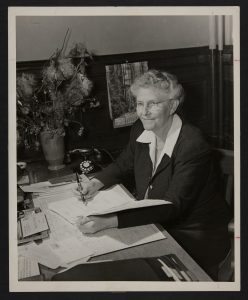
When Allyn retired in 1948, she left behind a legacy that was hard to follow. Accounts of her career at Mount Holyoke and beyond all reflect the intelligent, caring, and pioneering woman she proved to be. Whether you are looking at her work in the field or her profound influence on Mount Holyoke and its anthropology department, Harriett Allyn demonstrates her eternal value as a member of the community. Without her support and contribution, it is possible that Mount Holyoke’s Anthropology Department would not exist today or, at the very least, would be many years behind. Harriett May Allyn left an everlasting mark on the school she loved and looking at the Anthropology Department today, it is impossible to ignore her profound influence.
Timeline of Harriett Allyn’s Life
1883
Harriett May Allyn is born on May 4th in New London, Connecticut
1901
Enrolls at Mount Holyoke College
1905
Graduates from Mount Holyoke College with a degree in Biology
1908-1909
Biology instructor at Lake Erie College
1912-1913
Zoology instructor at Vassar College
1913-1915
Instructor of Zoology at Hackett Medical College in Canton, China
1915-1919
Dean of Hackett Medical College in Canton, China
1920-1921
Instructor of Zoology at Mount Holyoke College
1922-1924
Dean and Instructor of Zoology at Hackett Medical College
1924-1929
Instructor of Zoology at Vassar College
1928
Travels to Europe with the American School of Prehistoric Research
1929
Participates in an all-woman excavation in Athlit, Palestine from April-June
1928-1929
Research Fellow in Anthropology at Yale University under Professor George Grant MacCurdy and the American School of Prehistoric Research
1929-1948
Academic Dean at Mount Holyoke College
1936
Allyn became the only U.S. woman delegate to attend meetings of the International Congress of Prehistoric and Protohistoric Sciences in Oslo, Norway
1957
Harriett M. Allyn passes away on July 8th in Los Angeles, California at age 74.
Works Cited
Harriett Allyn Papers, South Hadley, Massachusetts. Archives and Special Collections, Mount Holyoke College. Faculty file, LD 7092.8
Lynn Morgan (Mount Holyoke Professor of Anthropology) in discussion with Brittnee Worthy, November, 2016.
Mary Lyon’s Museum. Anthropology at Mount Holyoke: Teachers, Ancestors, and Artifacts. created by Professor Lynn M. Morgan’s course Anthropology 235: “The Development of Anthropological Thought”. Last modified May, 2015. https://dla.mtholyoke.edu/exhibits/show/anthromhc
All photographs are courtesy of the Mount Holyoke College Special Collections and Archives.
Written by Brittnee Worthy, Class of 2017
- ASCMHC, Harriet Allyn Papers, Report Concerning Anthropology at Mount Holyoke, 1930-31 ↵
- ASCMHC, Harriet Allyn Papers, account of Harriett Allyn by Mrs. George Grant MacCurdy in “Memorial Service for Harriett M. Allyn.” ↵
- ASCMHC, Harriet Allyn Papers, account of Harriett Allyn by Mrs. George Grant MacCurdy in “Memorial Service for Harriett M. Allyn.” ↵
- ASCMHC, Harriett Allyn Papers, account of Harriett Allyn by Mrs. George Grant MacCurdy in “Memorial Service for Harriett M. Allyn.” ↵
- ASCMHC, Mount Holyoke Alumnae Quarterly, 1948. ↵
- Anthropology was made its own department at Mount Holyoke College in 1929, the same year Allyn became academic dean. ↵
- ASCMHC, Harriett Allyn Papers, Letter to President Ham, June 30, 1941. ↵
- ASCMHC, Harriett Allyn Papers, Annual Report to President Woolley. ↵